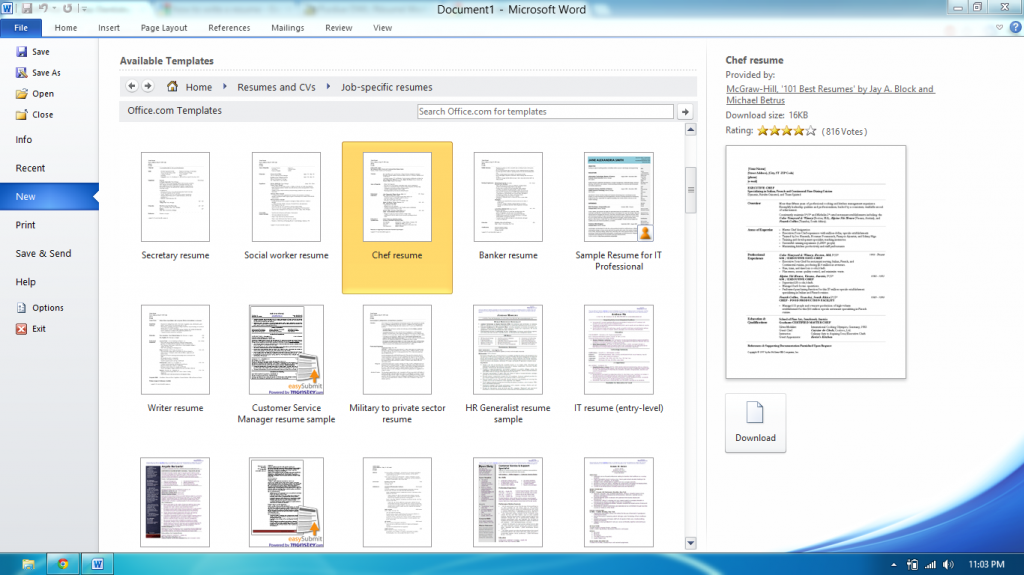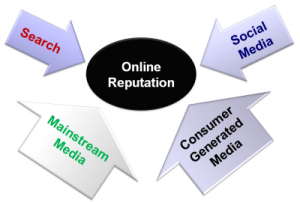 At my interview a few weeks ago for the research position, I brought several documents with me in a binder. Two copies of my resume, a business card, a letter of recommendation demonstrating a strong work ethic, and 2 awards I received demonstrating good team work skills. The key document in that binder was the resume which is a brief account of one’s professional or work experience and qualifications. Apart from the application, the resume is the first thing an interviewer will look at, and as a result, it’s perfection is key. A resume should be sculpted to perfection and geared towards EVERY specific position so that the interviewer will be amazed with the accomplishments you have achieved and can clearly apply your skill set to that needed to fill the open position. The personalization also helps impress the interviewer as it gives them an idea of how important getting the position is to you and how serious you are about it. For these reasons, I believe it is vital for the first guide in the portfolio building series to be dedicated to creating and perfecting a resume.
At my interview a few weeks ago for the research position, I brought several documents with me in a binder. Two copies of my resume, a business card, a letter of recommendation demonstrating a strong work ethic, and 2 awards I received demonstrating good team work skills. The key document in that binder was the resume which is a brief account of one’s professional or work experience and qualifications. Apart from the application, the resume is the first thing an interviewer will look at, and as a result, it’s perfection is key. A resume should be sculpted to perfection and geared towards EVERY specific position so that the interviewer will be amazed with the accomplishments you have achieved and can clearly apply your skill set to that needed to fill the open position. The personalization also helps impress the interviewer as it gives them an idea of how important getting the position is to you and how serious you are about it. For these reasons, I believe it is vital for the first guide in the portfolio building series to be dedicated to creating and perfecting a resume.
When I wrote my first resume in 2008, I had no idea what I was doing. It was for a job search engine optimizing (SEO) a website that sold home made crafts through an online store. I was asked for a resume hours before the online interview and since I didn’t have one prepared, I quickly make one from scratch. I had no idea how to write a proper resume, let alone what to write in it. I had no confidence in my own accomplishments and was not able to display my achievements effectively. Here is the original copy I emailed to the business owner. Needless to say I didn’t get the position.
The next resume was for an Intel Internship during the summer of 2009. This was a much more serious position and I had plenty of time to prepare and create the resume for the position. I researched the basic parts of a resume and modified my original design to be better structured and more informational. Unfortunately, I didn’t get this internship either; however, that same summer I found another internship at Prima Games, a company that publishes most of the video game guides sold for games like Call of Duty . The resume I sent them was a modified version of the one I gave to Intel.
The following school year I was required to make a new resume for my dental assisting courses from scratch. Using resources provided by the dental assisting school, I created a resume template that I am still satisfied with and still use as my primary template today. This template has gone through many revisions including: a job as a dental assistant, a position as the ASDA @ UCI treasurer for the 2011-2012 school year, and my recent research position. As you can see, they are all slight variants of each other with emphasis on qualities that are related to the position. I would recommend loading up all of the resumes listed above and compare them side by side to see how they differ and evolve over time.
Regardless of how far you are already in the resume making process I would undoubtedly recommend reading through the following guide, tips, and examples.
In my experiences mentoring other pre-dental students, I have noticed that many of my mentees do not have a resume yet. And when I ask them for their reasoning, their answer is that they do not feel like they have anything to write about. This seems to be the biggest hurdle for everyone. I felt exactly like that when I was writing my resumes for the home craft online store. However, by giving my resume time to evolve through several intermediate revisions, I turned my disaster of a first resume into a professional document representing me. For those just starting, my advice is to begin with a brainstorming phase. Just start writing down things you have done and skills you have gained from these experiences. Experiences as simple as being a club member are great to have and can be used to show what you are involved in. Give this brainstorming period a fair amount of time and energy and you’d be surprised at how much you have accomplished over the years. Taking this first step by writing things down in a list will help relieve the stress involved in drafting your first resume.
Start adding details to this list. Gather as much detail as possible. Experiences, like internships, or events, like fundraisers, should have names, dates, phone numbers, and descriptions. Group the skills into categories and write a description of how that skill could benefit an employer in general. Going through this brainstorming phase will not only start building a foundation network to your resume, but it will also help you explain any part of your resume when asked about it in an interview.
Now open a new document and begin composing the resume. Writing a resume involves balancing several factors just enough to come off as professional to an interviewer. The key factors are design, which includes formatting and organization organization, detail level, and experience. Composing the resume involves balancing these factors to work in unison.
Design, is very important. A resume with a good design will catch the readers attention, and if well structured, can impress an interviewer even with less experience than the other guy. Look through templates online and search google for resume examples. Microsoft Word and Publisher have many templates to choose from which are accessible by navigating to File->New and searching for “Resume”. This process should take some time. Pick a template that fits you, demonstrates professionalism, and is easy to read.
Once you have found your template, begin filling in the basic fields and experiences and skills sections based on the brainstorming done earlier. I recommend referencing a guide sheet for resume writing, which helped me write my own. It explains the goal of each section in a basic resume. Find and use “resume verb” lists like this one to help write your resume using professional and proper diction. Some of these words can completely change the emphasis on a specific experience or skill, and as a result this step is highly encouraged.
After you have filled out the resume template as best as possible, share it with some friends and have them evaluate several factors. The evaluation point is the resume’s first impression when you handed it to them, if it was professional, cluttered, too much white space, etc. Next have them evaluate the content for any cliche or odd areas. These areas will stand out like a sore thumb, and so it is important to not have anything that deters from the resumes primary focus. The final part of the evaluation is grammar usage. When it comes to resumes, one grammar mistake could easily leave your resume in the trashcan.
After receiving your evaluations modify the resume accordingly until it is approacing a final draft stage. At this point I would highly recommend going to a resume workshop and having your resume evaluated by somebody who has much experience doing so. You will get great tips and revision recommendations from these professional individuals.
My final piece of advice is, do not lie, do not lie, DO NOT LIE! It’s not worth it. Trust me! The lie may slip through the cracks and you may get the job, but eventually they will find out and when that day comes your integrity will disappear. Earn the position the right way.
UPDATE 5/03: What perfect timing! Apparently Yahoo’s CEO, Scott Thompson, lied on his resumes to Yahoo and PayPal about his education history by claiming he had a computer science degree. Unfortunately for him, his lie was exposed today, and now his reputation in the technology industry is for sure tarnished.
UPDATE 10/14/2022: After 10 years, I am removing the links to past resumes to limit personal information online. Please visit https://www.linkedin.com/in/eliasalmaz/ for a comprehensive list. You are welcome to contact me through Ask Elias and request copies of the old resume.
If you would like me to review your resumes send them in using the Ask Elias page. NOTE: The only accepted file types are .doc, .docx, .pub, .pdf. If I am missing your file type, send me an email using the same form and I will add it.





